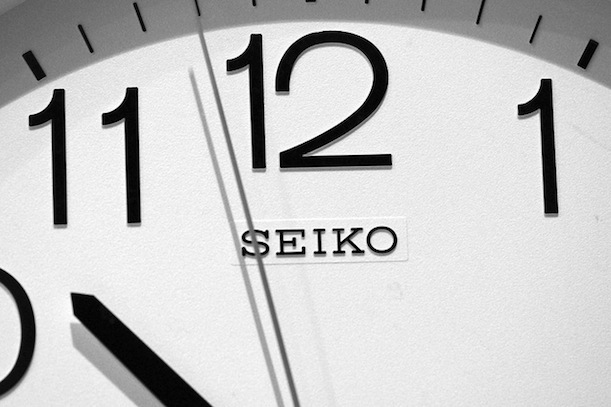World’s Newest Atomic Clock Loses 1 Second Every 50 Billion Years
Tired of your clocks losing time? A new clock, which is the most accurate ever, uses ytterbium atoms and lasers to precisely define a second
![]()

Tired of your wristwatches losing time as the years go by? A new atomic clock, which is the most accurate ever, uses ytterbium atoms and lasers to precisely define a second. Image via Flickr user Earls37a
If the watch on your wrist ran slow by five minutes over the course of a year, you probably wouldn’t think anything of it. But scientists and engineers rely on ultra-accurate atomic clocks for a range of applications, and the quest for ever-more-accurate clocks has gone on for millennia.
Now, a group of researchers led by Andrew Ludlow of the National Institute of Standards and Technology has set the bar higher than ever. Their newest atomic clock, unveiled yesterday, is predicted to become inaccurate by an amount of 1.6 seconds of time after running for a total of 1018 seconds—or, in other words, it loses one full second over the course of about 50.8 billion years.
In the paper describing their clock, the researchers provided a pair of analogies for this level of accuracy: “ is equivalent to specifying the age of the known universe to a precision of less than one second,” they wrote, “or Earth’s diameter to less than the width of an atom.”
Like all clocks, atomic clocks keep consistent time by basing the duration of a second off a physical event that happens with regularity. While mechanical clocks use the swinging of a pendulum to maintain time, atomic clocks use a mechanism that occurs with even more regularity: the specific frequency of light needed to cause an atom to fluctuate between two energy states (specifically, to go from a ground state into an excited state), which is always a uniform value. For example, the current international standard that defines the duration of a second is 9,192,631,770 cycles of the amount of microwave radiation that causes cesium atoms to fluctuate between the two energy states and in the process emit the most light possible.
A few factors, though, can distort even the most careful measurements of this frequency. What the researchers behind this new clock have done is create an innovative design (using a different element) that minimizes these distortions more than any clock before.
Their design, called an “optical lattice clock,” traps ytterbium atoms inside a lattice box of laser beams. Held in place, the atoms are bombarded by a second type of laser, which forces their electrons to jump up in energy level. A sensor checks to make sure that all the atoms reach the higher energy level, and the precise light frequency needed to force them to do so is then converted into the exact length of a second.
Normally, any slight physical movement of the atoms as they’re bombarded can lead to subtle changes in the frequency of light needed to raise their energy level (a result of Doppler shift), throwing off the accuracy of the clock. But, as described in the MIT Technology Review, where news of the clock was first published, the box of laser beams “holds the atoms in a vice-like grip that minimises any Doppler effects.” Additionally, the lattice traps a relatively large number of atoms (between 1,000 and 1,000,000) compared to most atomic clocks, so averaging the amount of radiation needed to raise each of these to the higher energy level provides a more accurate value of the radiation’s precise frequency, which is then used to set time.
Comparing two such clocks together, the authors found something remarkable–each “tick” measures intervals of time so perfectly that one clock will only lag behind the true time by a tenth of a second when our Sun envelopes the Earth as it evolves into a red giant about 5 billion years from now.
This new clock—and the gradual refinement of atomic clocks as a whole—might seem like a purely academic pursuit, but in reality there are a ton of very useful applications of the technology. Take, for instance, the “maps” app on your phone. Without the ability to closely synchronize clocks over great distances, the GPS system wouldn’t be able to work, because it relies upon the exact comparison of the time it takes signals to travel from several different satellites to your GPS-enabled device.
Future pursuits that could use this newest advance in atomic clock technology could fall within the science of geodesy, which seeks to precisely measure tiny changes in Earth’s shape and its gravitational field over time. All clocks tick at infinitesimally slower rates at sea level than at a mile high, because the force of gravity is stronger when closer to the Earth. Currently, with the most sophisticated atomic clocks, this difference in speed can only be measured when elevation changes by thousands of feet, but with the new clock, they will be detectable when the clock is raised or lowered by a mere centimeter, making the system potentially useful for measuring slight changes in glacier ice thickness or elevation gained by mountain ranges over time as tectonic plates collide.
/https://tf-cmsv2-smithsonianmag-media.s3.amazonaws.com/accounts/headshot/joseph-stromberg-240.jpg)
/https://tf-cmsv2-smithsonianmag-media.s3.amazonaws.com/accounts/headshot/joseph-stromberg-240.jpg)